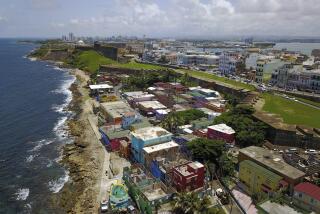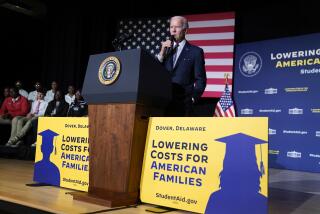Puerto Rico, $70 billion in debt, seeks bankruptcy protection
Puerto Rico Gov. Ricardo Rossello said Wednesday that federal courts would help protect the U.S. territory from its more than $70-billion debt crisis, after multiple creditors filed lawsuits trying to recuperate millions of dollars invested in government bonds.
Rossello said negotiations with bondholders had failed, forcing the government to seek relief through a bankruptcy-like move available under Title III of a federal law called Promesa.
Some of the island’s debts will go before a federal bankruptcy court, making it the largest U.S. government entity to seek such protection from creditors.
“Given the deficit that we have inherited, it is my responsibility to guarantee the best interests of the Puerto Rican people,” Rossello said at a news conference.
“We are here to address the problems of Puerto Rico, not to look at the past, and I am convinced that our island will be able to resume the path of economic development with the correct steps of the government and the commitment of each one of its residents,” he said.
Unlike states, Puerto Rico is not allowed to restructure its debt under Chapter 9 bankruptcy.
Promesa, signed into law last June, includes an oversight board aimed at helping the island manage its public finances. It provides temporary protection from litigation, but that expired this week.
The new conditions call for a federal district judge to be in charge of the restructuring.
The in-court debt restructuring process helps avoid a potentially messy legal battle with creditors. Some debts are expected to be resolved through ongoing negotiations.
Puerto Rico’s decision to seek protection from creditors did not surprise analysts, who said it was a necessary step toward solving the island’s crippling financial woes.
There are multiple reasons for Puerto Rico’s troubles, analysts, officials and residents say, including decades of poor fiscal management and the failure to build the tourism industry to its full potential.
The phasing out in 2006 of Internal Revenue Service tax incentives offered to U.S. companies operating on the island also hurt because firms moved elsewhere, resulting in job losses. Hundreds of thousands of Puerto Ricans, who are U.S. citizens at birth, have left the island of about 3.4 million people in favor of the mainland.
“Puerto Rico has been living on borrowed time,” said Brad Setser, senior fellow at the Council on Foreign Relations. “It was the right decision to seek Title III and the right decision to grant it.”
The decision to seek federal protection means that any lawsuits that have been filed will be stopped and a restructuring plan will be made.
“This helps the public in that there’s this ever-growing problem that they feel isn’t being dealt with,” said Milton Vescovacci, a partner at the law firm GrayRobinson in Miami. “This will give some certainty to the community and businesses so that things can get back to normal.”
In the midst of Puerto Rico’s financial calamity, Rossello, a scientist and the son of a former governor of the island, has been advocating for Puerto Rico to gain statehood as a way to help it dig out from debt.
Congress made Puerto Ricans U.S. citizens in 1917, and commonwealth status, which provides some autonomy, began in 1952. The island was ceded to the U.S. by Spain at the end of the Spanish-American War in 1898.
A nonbinding referendum on whether Puerto Rico’s voters favor statehood, independence/free association or the current status is planned for June 11.
Whatever the official status, many observers said the bottom line was that conditions on the island needed to improve.
“People are leaving, and you hear about power outages and power companies not being able to assist,” Vescovacci said. “That’s stuff you hear about in Third World countries, not in a cosmopolitan location.”
Follow me on Twitter @melissaetehad
UPDATES:
4:15 p.m.: The story was updated with additional comments and background.
The story was originally published at 11:15 a.m.
More to Read
Start your day right
Sign up for Essential California for news, features and recommendations from the L.A. Times and beyond in your inbox six days a week.
You may occasionally receive promotional content from the Los Angeles Times.







